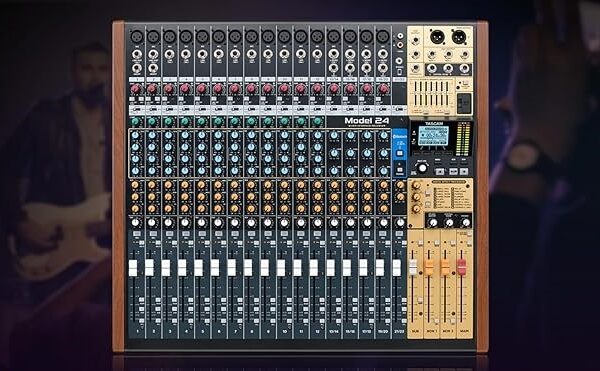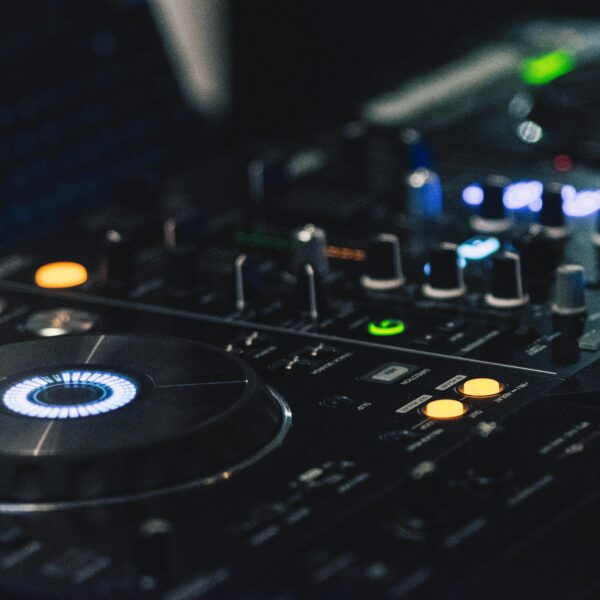If you need high-performance audio, you need PCIe audio interfaces.
Back in the early days, I was just a music producer juggling countless USB and FireWire audio interfaces. Every session came with frustrating latency issues and glitchy recordings
I remember the moment vividly: a critical project deadline, and my system just couldn’t keep up. That failure pushed me to explore better solutions. Enter PCIe audio interfaces—which finally gave me the smooth workflow I dreamed of.
If you’ve ever struggled with audio bottlenecks, it’s time to discover how PCIe can help you with that.
Did you know that PCIe can deliver up to 32GB/s bandwidth, ensuring crystal-clear audio processing? If you’re serious about professional-grade sound, understanding PCIe technology is essential.
The List of Best PCI Express audio interface
In this article, we’re diving into the top 7 PCIe audio interfaces on the market. We’ll break down what makes each one unique and how they can elevate your audio game. So, let’s explore the best of the best, and help you find the perfect fit for your needs!
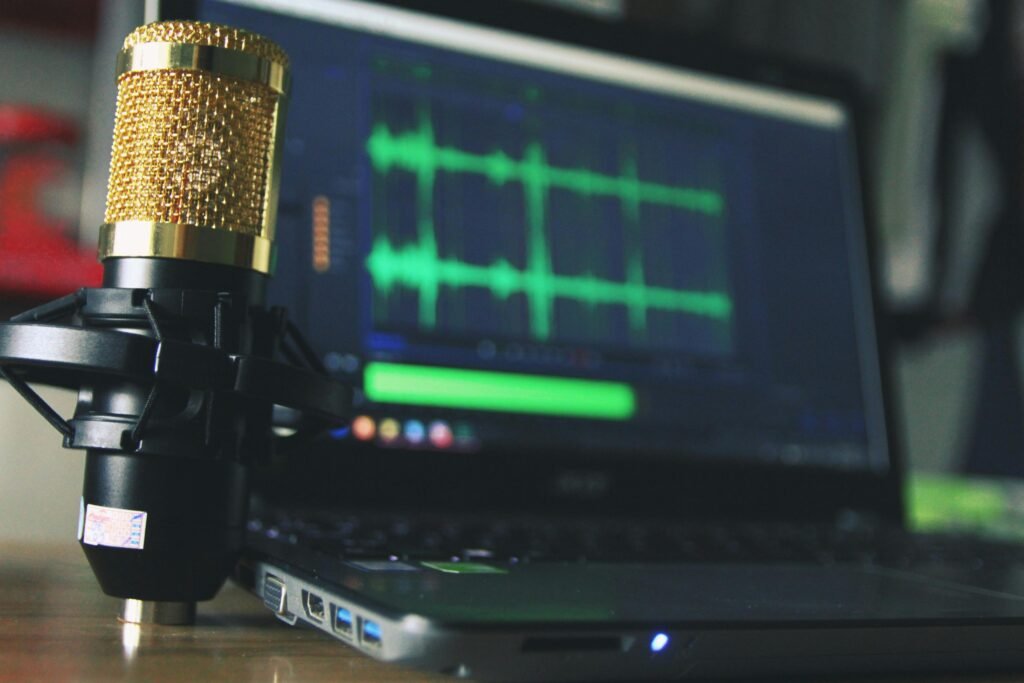
1. RME HDSPe MADI FX
Let’s kick things off with the RME HDSPe MADI FX, a powerhouse designed for serious studios or live sound setups that need to handle a ton of audio channels. If you’re working with big sessions, like recording a live band with tons of instruments or managing a complex studio setup, this one’s got your back.
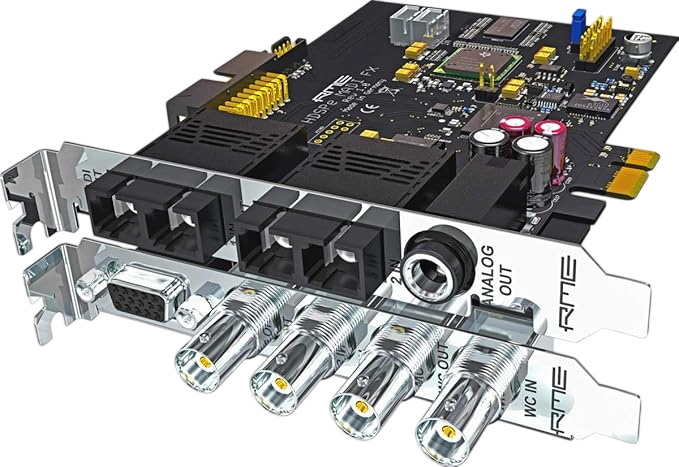
What makes the RME HDSPe MADI FX stand out?
First up, it can handle a whopping 390 audio channels.
That’s right—390!
This audio interface excels at handling complex audio setups, making it ideal for syncing multiple microphones, instruments, and external gear during large sessions. 🎵
The standout feature?
MADI (Multi-channel Audio Digital Interface).
It’s a rock-solid standard for transmitting high-channel-count audio over long distances—perfect for pros who need reliable, interference-free connections in complex setups.
Some users criticize its initial setup as technical, but once it’s configured, it’s smooth sailing.
In simple terms,
if you need bulletproof audio connectivity and flawless multi-source management, the RME HDSPe MADI FX won’t let you down. 🎶 Flexibility, reliability, and top-notch sound—it has it all!
2. Universal Audio Apollo X16
Next up, we have the Universal Audio Apollo X16 PCIE Audio Interface—a game-changer if you’re looking for high-end sound quality and real-time processing power. This is the kind of interface you’d find in professional studios, and for good reason. It’s got the performance and features that make it a top choice for those who take their audio production seriously.

What makes the Apollo X16 so special?
For starters, it offers 18 inputs and 20 outputs, so you’ve got plenty of room for everything, from microphones to instruments to external gear.
If you’re tracking a full band or mixing a podcast with lots of guest appearances, you’ll never run out of input channels.
But here’s the thing—UAD HEXA Core DSP.
That’s a fancy way of saying you can run Universal Audio’s suite of premium plugins directly in the interface, without putting a strain on your computer.
Thanks to real-time processing, you get zero-latency mixing with pro-grade compressors, EQs, and reverbs—all while recording.
It’s like having a high-end analog studio in a single box, minus the messy cables. 🎛️
But what actually makes it the real baddie?
129 dB dynamic range. That’s insanely high, ensuring every detail is crystal clear—from delicate whispers to crushing guitar riffs. No unwanted noise, no muddiness—just polished, professional sound right out of the gate.
If you want pristine audio, seamless plugin integration, and extensive I/O, the Apollo X16 is a serious contender.
But at this price, I wish they included Thunderbolt cables instead of making us buy them separately. 🤨
3. Focusrite RedNet PCIeR
Let’s talk about the Focusrite RedNet PCIeR—an interface that brings some serious networking power to the table. If you’re working in a larger studio or need to integrate multiple devices across different locations, this one might just be your new best friend.
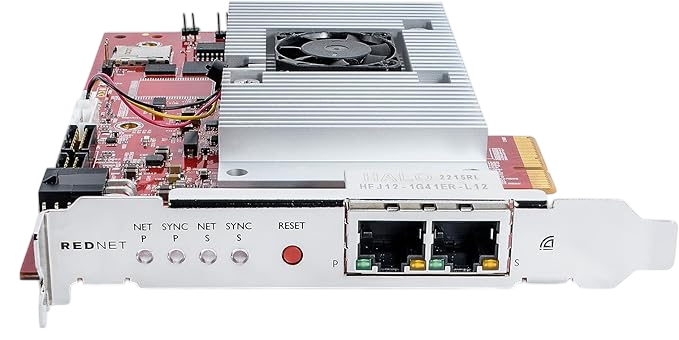
What sets the RedNet PCIeR apart?
First off, it’s all about Dante networking. This interface connects to a Dante network, which means you can route audio across multiple devices with minimal hassle.
Imagine sending 128 channels of audio over a single network cable—no tangled mess, no headaches. That’s what makes this setup a beast especially when linking multiple computers, audio interfaces, or entire studios.
But what really blew me away?
Ultra-low latency. Just 2.5ms—practically instant.
If you’ve ever dealt with laggy monitoring while tracking instruments or vocals, you know how frustrating it gets. With this, everything feels real-time, making recording and live sound effortless. 🎧
And let’s talk about scalability. Whether you’re handling a massive live show or a studio packed with gear, this system keeps up—no dropouts, no compromises.
But here’s the thing:
it’s not cheap, and setting it up isn’t plug-and-play. If you’re not tech-savvy, expect a learning curve.
Still, for professionals who demand speed, reliability, and insane channel counts, it’s a solid investment.
So, if you’re working in a complex studio environment where flexibility and low latency are key, the Focusrite RedNet PCIeR is a fantastic choice. It’s all about making your setup as efficient as possible without compromising on sound quality.
4. Lynx E44 PCI Express
Next, let’s dive into the Lynx E44 PCI Express, a compact but mighty interface that delivers top-notch audio quality with ultra-low latency. If you’re working in a smaller studio or just need a straightforward, reliable interface without breaking the bank, this one’s a solid option.

The Lynx E44 stands out with 4 analog I/O channels and 24-bit/192kHz resolution, delivering pro-level audio clarity for tracking, mixing, and mastering. 🎧
What really sets it apart? Minimal jitter and ultra-low latency.
Jitter causes distortion when digital signals aren’t transmitted accurately, leading to glitches and timing errors. With the E44’s rock-solid clocking, you get flawless recordings and playback—no unwanted artifacts, just crystal-clear audio.
Its compact, no-fuss design is another win. Unlike bulky interfaces, this fits seamlessly into tight studio spaces.
I’ve set up plenty of gear, and honestly, the E44’s ease of use is refreshing—plug it in, tweak a few settings, and you’re good to go. No steep learning curve, no unnecessary complexity.
For those craving studio-grade sound in a streamlined package, the Lynx E44 is a solid choice. High performance, low hassle, and no inflated price tag—exactly what modern producers and audio engineers need. 🚀
5. MOTU 112D PCIE Audio Interface
Now, let’s take a look at the MOTU 112D, a sleek and powerful interface that combines audio quality with versatility. Whether you’re recording in a studio, working on a live event, or integrating different audio systems, this interface packs a punch and delivers solid performance every time.
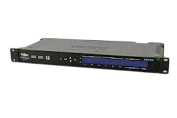
Need to connect mics, instruments, or racks of outboard gear? It’s got you covered. Plus, with 24-bit/192kHz resolution, your audio stays crystal clear, no compromises.
But here’s the real thing: AVB networking.
Unlike traditional setups with messy cables and signal loss, AVB (Audio Video Bridging) sends audio over Ethernet with ultra-low latency and rock-solid reliability. If you’re syncing multiple studios or managing a live show, it eliminates signal dropouts—something I’ve struggled with before in complex setups. According to AES, AVB reduces jitter and improves synchronization by up to 90%. That’s a huge deal in professional audio.
Another killer feature?
The touchscreen interface. No more digging through clunky software—just tap, adjust, and go.
When you’re mid-session or handling a live gig, that speed matters. Some interfaces bury controls under layers of menus (cough RME TotalMix cough), but the 112D keeps it simple.
Bottom line?
If you need a pro-grade interface with top-tier networking and flexibility, the MOTU 112D is a powerhouse. It’s not just another audio interface—it’s a studio + live setup solution in one.
6. RME HDSPe RayDAT
Next up, we’ve got the RME HDSPe RayDAT, a true professional’s interface that brings exceptional audio performance to the table. If you’re running a high-demand studio, particularly with a need for multiple I/O channels, this one will quickly become your go-to.
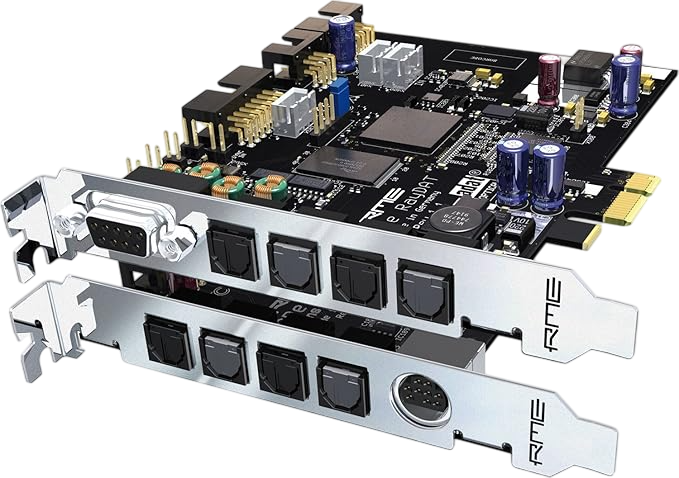
What makes the RME HDSPe RayDAT stand out?
For starters, it offers 32 channels of I/O, making it ideal for large-scale setups where you need to connect several pieces of equipment at once.
If you’re working with a big ensemble, a multi-mic recording session, or routing audio through various processors, the RayDAT gives you all the inputs and outputs you need.
It’s built for those who need rock-solid reliability, especially in a professional or studio setting.
This interface uses RME’s unique drivers, which are known for being stable, low-latency, and highly efficient. The total mix software that comes with it gives you intuitive control over your audio routing and mixing, so you can customize the setup exactly the way you want it.
You’ll have full flexibility over your audio signal flow, allowing for quick adjustments during recording or mixing.
What’s also impressive is the MADI (Multichannel Audio Digital Interface) support, which allows you to easily connect to larger systems or other MADI-compatible equipment, expanding your system’s capabilities further.
This makes the RayDAT a perfect choice for professional studios that need to handle complex routing across many devices.
In a nutshell,
the RME HDSPe RayDAT is a powerhouse for anyone who needs to handle a ton of channels while ensuring high-quality audio and ultra-low latency.
7. ESI Maya44 EX
Last but definitely not least, we have the ESI Maya44 EX—a great choice if you’re looking for a budget-friendly PCI Express audio interface that still packs a punch in terms of performance. While it’s not as high-end as some of the other options on this list, it’s perfect for home studios or smaller setups where you need solid audio quality without the hefty price tag.
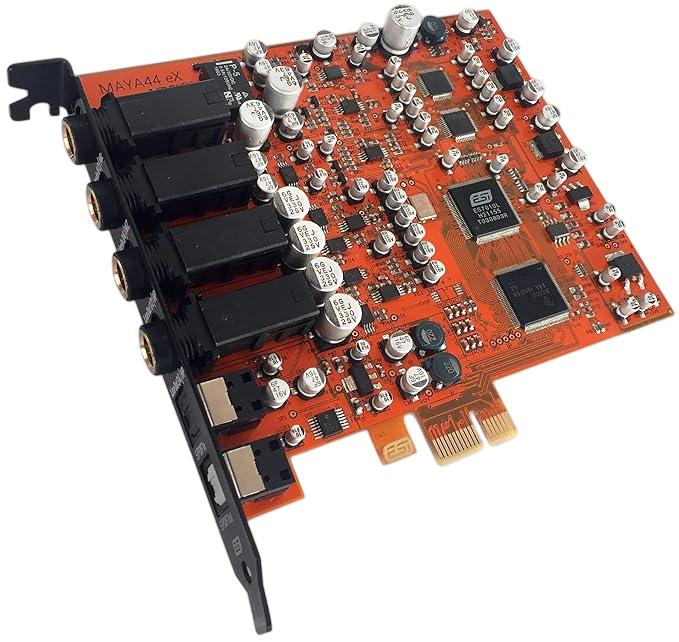
What makes the ESI Maya44 EX stand out?
For starters, it offers 4 inputs and 4 outputs, which is plenty for smaller recording setups, podcasts, or basic music production.
If you’re tracking vocals, guitar, or a couple of instruments, the Maya44 EX gives you everything you need for multi-track recording without overcomplicating things.
One of its standout features is its 24-bit/192kHz resolution, which means you’re getting professional-grade audio quality at an affordable price.
The interface also provides low-latency performance, so you won’t experience the frustrating delay that can come with cheaper interfaces.
Despite being on the more affordable side, the Maya44 EX also includes ASIO drivers, ensuring you get the kind of low-latency performance that professional studios rely on.
Plus, it’s compatible with both Mac and PC, which adds to its versatility.
If you’re just starting out or you need a reliable interface that won’t break the bank, the ESI Maya44 EX is a fantastic option.
It might not have all the bells and whistles of the higher-end models, but for the price, it delivers solid audio quality and performance that’ll get the job done.
Perfect for podcasters, musicians, or anyone with simpler needs looking to step up their audio game.
Best PCI Express Audio Interfaces in a Nutshell
| # | Product Name | Key Features | Why You Should Buy |
|---|---|---|---|
| 1 | RME HDSPe MADI FX | – Handles 390 audio channels – MADI support for reliable long-distance audio transmission | – Perfect for large-scale sessions or live events – Handles complex audio setups with ease – Provides high-quality audio and flexibility for multiple sources |
| 2 | Universal Audio Apollo X16 | – 18 inputs, 20 outputs – UAD HEXA Core DSP for real-time plugin processing – 129 dB dynamic range | – Pristine audio quality and seamless plugin integration – Real-time processing with zero latency – Ideal for professional studios needing high-end performance and versatility |
| 3 | Focusrite RedNet PCIeR | – Dante networking for up to 128 audio channels – 2.5 ms ultra-low latency | – Great for complex, scalable studio setups – Minimizes lag and maximizes efficiency with low-latency performance – Ideal for integrating multiple devices or locations |
| 4 | Lynx E44 PCI Express | – 4 analog I/O channels – 24-bit/192kHz resolution – Minimal jitter and low latency | – Compact and affordable for home studios – High-quality audio in a simple, no-fuss design – Easy to set up and operate for non-tech experts |
| 5 | MOTU 112D PCIE Audio Interface | – 48 audio channels with analog and digital I/O – AVB networking support – 24-bit/192kHz resolution – Touchscreen interface | – Perfect for both small and large-scale setups – Low-latency audio transmission over AVB – Convenient touchscreen control for live or on-the-go recording |
| 6 | RME HDSPe RayDAT | – 32 channels of I/O – MADI support – Stable, low-latency drivers – TotalMix software for intuitive routing control | – Ideal for large-scale setups or professional studios – Reliable performance with multiple audio channels – Flexibility and high-quality audio routing for complex configurations |
| 7 | ESI Maya44 EX | – 4 inputs, 4 outputs – 24-bit/192kHz resolution – Low-latency ASIO drivers – Compatible with both Mac and PC | – Budget-friendly option for home studios or smaller setups – Solid audio performance at an affordable price – Provides professional-grade quality for entry-level users or podcasters/musicians |
Conclusion
From the high-channel-count powerhouses like the RME HDSPe MADI FX to the compact yet mighty Echo AudioFire Pre8, each of these interfaces offers unique features that can streamline your workflow and enhance your audio quality.
Are you working in a large studio and need tons of I/O?
Go for something like the MOTU 1248 or PreSonus Quantum 4848. If ultra-low latency and pristine sound quality are at the top of your list, the Universal Audio Apollo X16 or Focusrite RedNet PCIeR might be your best bet.
And if you’re just looking for a reliable, high-quality interface on a budget, the Lynx E44 or Echo AudioFire Pre8 will get you there without breaking the bank.
Into Podcasting? Podcasting is a different game, and without a precise blueprint, the game will get tougher midway. Grow your podcast from scratch with Zero Audience and learn about how successful podcasters cracked the code by winning our Free Guide with step by step Guidelines.
Get your complete podcast equipment setup by visiting Podcast Equipment Bundle. Don’t let the side projects kill your time. Get in touch with podcasting services and experts those will save you tons of time at Podcast Production Services.
With that being said, Let’s connect with all such free and paid tool/services you might need knowingly or unknowingly to fuel your growth. Here’s 21 BEST AI TOOLS AND PLATFORMS TO GROW YOUR PODCAST AND CONTENTS. There are some bonus tools in the end too to make your day to day life easier.
There are some affiliate links on this page that will redirect you directly to the original products and services. Also by buying through those links you will be supporting us. So thank you ^.^
Related Posts
Here’s a list of blog posts various types of audio interfaces that you can consider as alternative options to.
- USB Audio Interfaces
- Telephone Audio Interfaces
- 4 XLR Input Audio Interface
- Audio Interface for Mac
- DC-Coupled Audio Interfaces
- PCIe Audio Interfaces
- Audio Interface Under $200
- Fairlight Audio Interface
- 12-Input Audio Interface
- Audio Interfaces with Bluetooth


